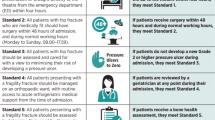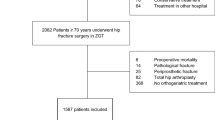Abstract
Summary
The challenges of hip fracture care in Malaysia is scarcely discussed. This study evaluated the outcomes of older patients with hip fracture admitted to a teaching hospital in Malaysia. We found that one in five individuals was no longer alive at one year after surgery. Three out of five patients did not recover to their pre-fracture mobility status 6 months following hip fracture surgery.
Purpose
With the rising number of older people in Malaysia, it is envisaged that the number of fragility hip fractures would also increase. The objective of this study was to determine patient characteristics and long-term outcomes of hip fracture in older individuals at a teaching hospital in Malaysia.
Methods
This was a prospective observational study which included consecutive patients aged ≥ 65 years old admitted to the orthopedic ward with acute hip fractures between March 2016 and August 2018. Patient socio-demographic details, comorbidities, pre-fracture mobility status, fracture type, operation and anesthesia procedure, and length of stay were recorded. Post-fracture mobility status was identified at 6 months. Cox proportional hazard analysis was used to assess the risk of death in all patients.
Results
310 patients (70% women) with the mean age of 79.89 years (SD 7.24) were recruited during the study period. Of these, 284 patients (91.6%) underwent surgical intervention with a median time to surgery of 5 days (IQR 3–8) days. 60.4% of patients who underwent hip fracture surgery did not recover to their pre-fracture mobility status. One year mortality rate was 20.1% post hip fracture surgery. The independent predictor of mortality included advanced age (hazard ratio, HR = 1.05, 95% CI = 1.01–1.08; p = 0.01), dependency on activities of daily living (HR = 2.08, 95% CI = 1.26–3.45; p = 0.01), and longer length of hospitalization (HR = 1.02, 95% CI = 1.01–1.04; p < 0.01).
Conclusion
One in 5 individuals who underwent hip fracture surgery at a teaching hospital in Kuala Lumpur was no longer alive at one year. A systematic approach to hip fracture management is crucial to improve outcomes and restore pre-fracture function of this vulnerable group of patients.



Similar content being viewed by others
References
Cheung CL, Ang SB, Chadha M, Chow ES, Chung YS, Hew FL et al (2018) An updated hip fracture projection in Asia: the Asian Federation of Osteoporosis Societies study. Osteoporos Sarcopenia 4(1):16–21
Jaafar N, Perialathan K, Krishnan M, Juatan N, Ahmad M, Mien TYS et al (2021) Malaysian health literacy: scorecard performance from a national survey. Int J Environ Res Public Health 18(11):5813
Ong T, Khor HM, Kumar CS, Singh S, Chong E, Ganthel K et al (2020) The current and future challenges of hip fracture management in Malaysia. Malays Orthop J 14(3):16–21
Tan MP, Kamaruzzaman SB, Poi PJH (2018) An analysis of geriatric medicine in Malaysia-riding the wave of political change. Geriatrics (Basel) 3(4):80
Downey C, Kelly M, Quinlan JF (2019) Changing trends in the mortality rate at 1-year post hip fracture - a systematic review. World J Orthop 10(3):166–175
Chan CY, Subramaniam S, Mohamed N, Ima-Nirwana S, Muhammad N, Fairus A et al (2020) Determinants of bone health status in a multi-ethnic population in Klang Valley, Malaysia. Int J Environ Res Public Health. 17(2):384
Abdullah MAH, Abdullah AT, (Eds). (2010) National Orthopaedic Registry of Malaysia (NORM). In: Annual report of National Orthopaedic Registry Malaysia (NORM) hip fracture. Jointly published by the National Orthopedic Registry of Malaysia (NORM) and the Clinical Research Centre (CRC), Ministry of Health Malaysia, Kuala Lumpur, p 35
Tay E (2016) Hip fractures in the elderly: operative versus nonoperative management. Singapore Med J 57(4):178–181
Yoon BH, Baek JH, Kim MK, Lee YK, Ha YC, Koo KH (2013) Poor prognosis in elderly patients who refused surgery because of economic burden and medical problem after hip fracture. J Korean Med Sci 28(9):1378–1381
Lim WX, Kwek EBK (2018) Outcomes of an accelerated nonsurgical management protocol for hip fractures in the elderly. J Orthop Surg (Hong Kong) 26(3):2309499018803408
Kawaji H, Uematsu T, Oba R, Takai S (2016) Conservative treatment for fracture of the proximal femur with complications. J Nippon Med Sch 83(1):2–5
Loggers SAI, Van Lieshout EMM, Joosse P, Verhofstad MHJ, Willems HC (2020) Prognosis of nonoperative treatment in elderly patients with a hip fracture: a systematic review and meta-analysis. Injury 51(11):2407–2413
Frenkel Rutenberg T, Assaly A, Vitenberg M, Shemesh S, Burg A, Haviv B et al (2019) Outcome of non-surgical treatment of proximal femur fractures in the fragile elderly population. Injury 50(7):1347–1352
Kim SJ, Park HS, Lee DW (2020) Outcome of nonoperative treatment for hip fractures in elderly patients: a systematic review of recent literature. J Orthop Surg (Hong Kong) 28(2):2309499020936848
Daraphongsataporn N, Saloa S, Sriruanthong K, Philawuth N, Waiwattana K, Chonyuen P et al (2020) One-year mortality rate after fragility hip fractures and associated risk in Nan. Thailand Osteoporos Sarcopenia 6(2):65–70
Rath S, Yadav L, Tewari A, Chantler T, Woodward M, Kotwal P et al (2017) Management of older adults with hip fractures in India: a mixed methods study of current practice, barriers and facilitators, with recommendations to improve care pathways. Arch Osteoporos 12(1):55
Hlaing WY, Thosingha O, Chanruangvanich W (2020) Health-related quality of life and its determinants among patients with hip fracture after surgery in Myanmar. Int J Orthop Trauma Nurs 37:100752
The National Institute of Clinical Excellence (2011) Clinical guideline 124. The management of hip fracture in adults. Available from: http://www.nice.org.uk/nicemedia/live/13489/54918/54918.pdf. Accessed 10 May 2022
Australian and New Zealand Hip Fracture Registry (ANZHFR) Steering Group (2014) Australian and New Zealand Guideline for hip fracture care: improving outcomes in hip fracture management of adults. Australian and New Zealand Hip Fracture Registry Steering Group, Sydney
Armstrong E, Yin X, Razee H, Pham CV, Sa-Ngasoongsong P, Tabu I et al (2022) Exploring barriers to, and enablers of, evidence-informed hip fracture care in five low-middle-income countries: China. Thailand, the Philippines and Vietnam. Health Policy Plan, India
Araiza-Nava B, Mendez-Sanchez L, Clark P, Peralta-Pedrero ML, Javaid MK, Calo M et al (2022) Short- and long-term prognostic factors associated with functional recovery in elderly patients with hip fracture: a systematic review. Osteoporos Int 33(7):1429–1444
Sheehan KJ, Goubar A, Martin FC, Potter C, Jones GD, Sackley C et al (2021) Discharge after hip fracture surgery in relation to mobilisation timing by patient characteristics: linked secondary analysis of the UK National Hip Fracture Database. BMC Geriatr 21(1):694
Handoll HH, Cameron ID, Mak JC, Panagoda CE, Finnegan TP (2021) Multidisciplinary rehabilitation for older people with hip fractures. Cochrane Database Syst Rev 11:CD007125
Sallehuddin H, Ong T (2021) Get up and get moving-early mobilisation after hip fracture surgery. Age Ageing 50(2):356–357
Acknowledgements
The authors are grateful to our research assistants Aun Yi Yang and Laila Bilqish for assisting in the data collection.
Funding
The study was funded by the University of Malaya Bantuan Kecil Penyelidikan (BK022-2016) research grant.
All authors declare that the manuscript has not been submitted to other journals for consideration of publication. The manuscript has also not been published previously.
Author information
Authors and Affiliations
Corresponding author
Ethics declarations
Conflicts of interest
None.
Consent to participate
Informed consent was obtained from all individual participants or their next of kin included in the study.
Additional information
Publisher's note
Springer Nature remains neutral with regard to jurisdictional claims in published maps and institutional affiliations.
Rights and permissions
Springer Nature or its licensor (e.g. a society or other partner) holds exclusive rights to this article under a publishing agreement with the author(s) or other rightsholder(s); author self-archiving of the accepted manuscript version of this article is solely governed by the terms of such publishing agreement and applicable law.
About this article
Cite this article
Khor, H.M., Tan, M.P., Kumar, C.S. et al. Mobility and mortality outcomes among older individuals with hip fractures at a teaching hospital in Malaysia. Arch Osteoporos 17, 151 (2022). https://doi.org/10.1007/s11657-022-01183-w
Received:
Accepted:
Published:
DOI: https://doi.org/10.1007/s11657-022-01183-w




